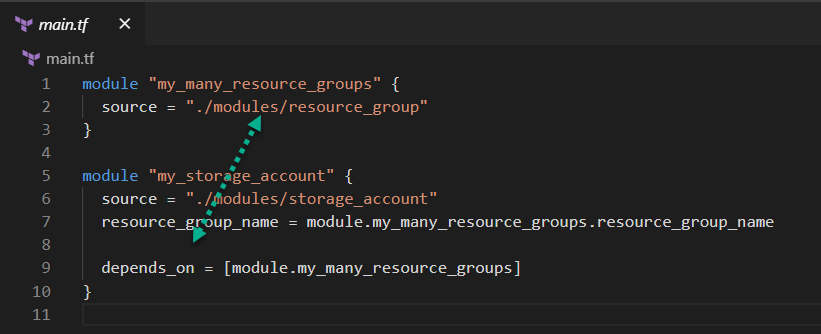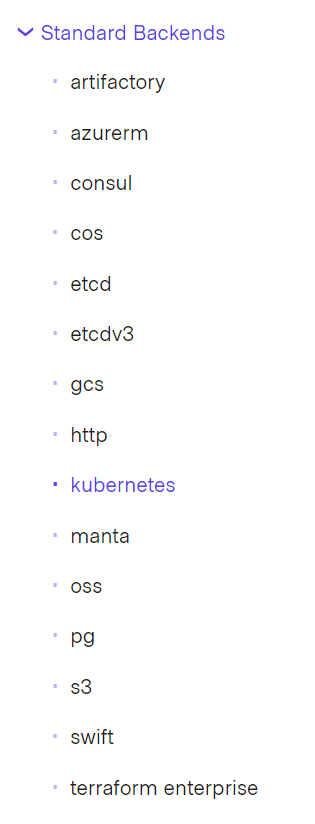Today I’d like to write a little bit about Terraform 0.13.0 which was released on the 10/08/2020
You can find the official release here:
https://github.com/hashicorp/terraform/releases/tag/v0.13.0
Unlike many other blogs on this subject, I have tried and tested all the new features below apart from the New Kubernetes remote state storage backend feature.
Some of the new features are as follows:
-
count and for_each for modules: Similar to the arguments of the same name in resource and data blocks, these create multiple instances of a module from a single module block. #24461
-
depends_on for modules: Modules can now use the depends_on argument to ensure that all module resource changes will be applied after any changes to the depends_on targets have been applied. #25005
-
Automatic installation of third-party providers: Terraform now supports a decentralized namespace for providers, allowing for automatic installation of community providers from third-party namespaces in the public registry and from private registries. (More details will be added about this prior to release - Obviously they forgot to update this part after the release! :))
-
Custom validation rules for input variables: A new validation block type inside variable blocks allows module authors to define validation rules at the public interface into a module, so that errors in the calling configuration can be reported in the caller’s context rather than inside the implementation details of the module. #25054
-
New Kubernetes remote state storage backend: This backend stores state snapshots as Kubernetes secrets. #19525
Working samples of the above list
Note that in my version.tf file I have the following which specifies Terraform version 0.13.0:
terraform {
required_version = "~> 0.13.0"
required_providers {
azurerm = {
source = "hashicorp/azurerm"
version = "~> 2.0"
}
}
}
Also, for completeness my provider.tf file looks like this as I am working with Azure:
provider "azurerm" {
version = "~> 2.0"
features {}
}
count and for_each for modules
count
This feature is very simple. You can easily create multiple instances of a module from a single module block.
So here is a scenario and remember this is very simplistic for the purposes of this demo.
We have a requirement to create three resource groups. They are all in the same region and their names will only differ by an integer suffix.
So we will end up with three resources groups as follows:
- rg-1
- rg-2
- rg-3
Firstly let’s write our resource group module. Here you can see the layout of my project. Note that I have placed my module in a local folder called /modules/resource_group:

resource "azurerm_resource_group" "example" {
count = var.instance_count
name = "${var.resource_group_name}${count.index + 1}"
location = "Australia East"
}
As you can see, this module takes a count from instance_count variable and it builds up its name using this count.
Now, in my main.tf file we will use this module to create three resources groups as mentioned in the scenario above.
I also have a couple of variables on my module that receive input from the consuming code:
variable "resource_group_name" {
type = string
default = "rg-"
}
variable "instance_count" {
type = number
}
module "my_many_resource_groups" {
source = "./modules/resource_group"
instance_count = 3
}
now we can run:
terraform initterraform plan
From the plan output we can see that Terraform will create the three resources groups as described above:
Terraform will perform the following actions:
# module.my_many_resource_groups.azurerm_resource_group.example[0] will be created
+ resource "azurerm_resource_group" "example" {
+ id = (known after apply)
+ location = "australiaeast"
+ name = "rg-1"
}
# module.my_many_resource_groups.azurerm_resource_group.example[1] will be created
+ resource "azurerm_resource_group" "example" {
+ id = (known after apply)
+ location = "australiaeast"
+ name = "rg-2"
}
# module.my_many_resource_groups.azurerm_resource_group.example[2] will be created
+ resource "azurerm_resource_group" "example" {
+ id = (known after apply)
+ location = "australiaeast"
+ name = "rg-3"
}
Plan: 3 to add, 0 to change, 0 to destroy.
It’s not fancy, but I hope you get the idea.
for_each
This feature is a little more complex but gives you much more control over the data in the map you iterate over to produce multiple resources from a single module.
In this scenario we will create a variable on our module that receives a map of objects that describes our resource group’s name and location:
variable "resource_groups" {
type = map(object({
name = string
location = string
}))
}
The code for our resource group within our module now looks like this:
resource "azurerm_resource_group" "example" {
for_each = var.resource_groups
name = each.value.name
location = each.value.location
}
And in our code that consumes the module we have this:
module "my_many_resource_groups" {
source = "./modules/resource_group"
resource_groups = local.resource_groups
}
and for simplicity I have hard coded the map into a local:
locals {
resource_groups = {
rg1 = {
name = "rg-1"
location = "Australia East"
}
rg2 = {
name = "rg-2"
location = "Australia SouthEast"
}
rg3 = {
name = "rg-3"
location = "Australia Central"
}
}
}
So in summary:
- we have three resource group properties defined in our map
- we pass this map into our module
- the module receives this data through the above mentioned variable
- the module iterates through the passed in data and deploys three resource groups with three different names into three different regions
An execution plan has been generated and is shown below.
Resource actions are indicated with the following symbols:
+ create
Terraform will perform the following actions:
# module.my_many_resource_groups.azurerm_resource_group.example["rg1"] will be created
+ resource "azurerm_resource_group" "example" {
+ id = (known after apply)
+ location = "australiaeast"
+ name = "rg-1"
}
# module.my_many_resource_groups.azurerm_resource_group.example["rg2"] will be created
+ resource "azurerm_resource_group" "example" {
+ id = (known after apply)
+ location = "australiasoutheast"
+ name = "rg-2"
}
# module.my_many_resource_groups.azurerm_resource_group.example["rg3"] will be created
+ resource "azurerm_resource_group" "example" {
+ id = (known after apply)
+ location = "australiacentral"
+ name = "rg-3"
}
Plan: 3 to add, 0 to change, 0 to destroy.
That’s it for now!
depends_on for modules
Modules can now use the depends_on property to ensure that all module resource changes will be applied after any changes to the depends_on targets have been applied.
This is what version 0.12.29 would have done if you attempted to use depends on with modules:
Error: Reserved argument name in module block
on main.tf line 9, in module "my_storage_account":
9: depends_on = [module.my_many_resource_groups]
The name "depends_on" is reserved for use in a future version of Terraform.
But now with Terraform 0.13.0 you can do this:

Admittedly, the above
depends_onexample is not great but you get the idea.
Automatic installation of third-party providers
In this section I will describe how to automatically install 3rd party providers.
We would like to automatically install the following two providers:
- Azure DevOps provider - https://registry.terraform.io/providers/ellisdon-oss/azuredevops/latest
- Terraform Random provider - https://registry.terraform.io/providers/hashicorp/random/latest
from the Terraform Registry which is here: https://registry.terraform.io/
So, in my versions.tf file I will do the following:
terraform {
required_version = "~> 0.13.0"
required_providers {
azurerm = {
source = "hashicorp/azurerm"
version = "~> 2.0"
}
azuredevops = {
source = "ellisdon-oss/azuredevops"
version = "0.0.2"
}
random = {
source = "hashicorp/random"
version = "2.3.0"
}
}
}
Then when we run terraform init -upgrade we see the providers being downloaded:
Note:
terraform init -upgradeblows any previous downloads away and gets fresh ones.
Upgrading modules...
- my_many_resource_groups in modules/resource_group
Initializing the backend...
Initializing provider plugins...
- Finding ellisdon-oss/azuredevops versions matching "0.0.2"...
- Finding hashicorp/random versions matching "2.3.0"...
- Finding hashicorp/azurerm versions matching "~> 2.0, ~> 2.0"...
- Installing ellisdon-oss/azuredevops v0.0.2...
- Installed ellisdon-oss/azuredevops v0.0.2 (self-signed, key ID 1033ECE171B90D34)
- Installing hashicorp/random v2.3.0...
- Installed hashicorp/random v2.3.0 (signed by HashiCorp)
- Installing hashicorp/azurerm v2.24.0...
- Installed hashicorp/azurerm v2.24.0 (signed by HashiCorp)
Partner and community providers are signed by their developers.
If you'd like to know more about provider signing, you can read about it here:
https://www.terraform.io/docs/plugins/signing.html
Terraform has been successfully initialized!
You may now begin working with Terraform. Try running "terraform plan" to see
any changes that are required for your infrastructure. All Terraform commands
should now work.
If you ever set or change modules or backend configuration for Terraform,
rerun this command to reinitialize your working directory. If you forget, other
commands will detect it and remind you to do so if necessary.
You can see that it downloaded the required providers for you.
I won’t go into the Azure DevOps provider but I will however show you an example of why I downloaded the Terraform Random provider.
You may remember that originally, the resource groups I am deploying were named like this: rg-1, rg-2 etc.
now we will use a randomly generated string instead:
resource "azurerm_resource_group" "example" {
count = var.instance_count
name = "${random_string.random.result}${count.index + 1}"
location = "Australia East"
}
resource "random_string" "random" {
length = 24
special = false
}
That’s all there is to it.
Custom validation rules for input variables
This section describes the new custom validation rules that you can add to your input variables. The idea here is you can control what is allowed / not-allowed to be passed in as a variable.
you may remember our resource_group_name variable from above. Here we have added some validation to it to ensure the name starts with rg-:
variable "resource_group_name" {
type = string
validation {
condition = can(regex("^rg-", var.resource_group_name))
error_message = "Hey, we have naming standards around here! Please prefix your resource group name with: \"rg-\"."
}
default = "nope"
}
And when we run terraform plan you can see that it stops you in your tracks:
Error: Invalid value for variable
on modules/resource_group/variables.tf line 1:
1: variable "resource_group_name" {
Hey, we have naming standards around here! Please prefix your resource group
name with: "rg-".
This was checked by the validation rule at
modules/resource_group/variables.tf:4,3-13.
You could also check the minimum length:
variable "resource_group_name" {
type = string
validation {
condition = length(var.resource_group_name) > 4 && substr(var.resource_group_name, 0, 4) == "rg-"
error_message = "Hey, we have naming standards around here! Please prefix your resource group name with: \"rg-\" and make sure it is more than 4 characters long."
}
default = "nope"
}
Obviously, don’t use validation as the only control around naming standards, maybe introduce a naming module to enforce naming standards.
New Kubernetes remote state storage backend
As mentioned above this feature allows you to store your Terraform state in a Kubernetes secret with locking done using a Lease resource.
Here are the details: https://www.terraform.io/docs/backends/types/kubernetes.html
I have not worked with this so it is hard for me to comment but I think the gist is that, Terraform has given us a new backend type.

I presume the benefit here is that you can store all your assets close the the product you are working on instead of having your state stored somewhere else such as an Azure Storage Account, for example.
Please feel free to let me know more about the Kubernetes remote state storage backend and I will update the information here.
Cheers Russ